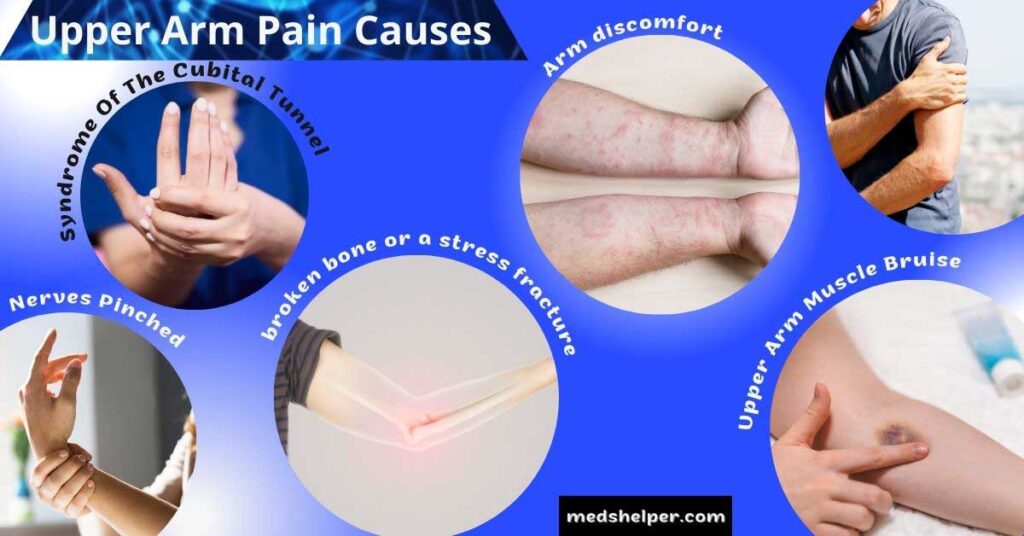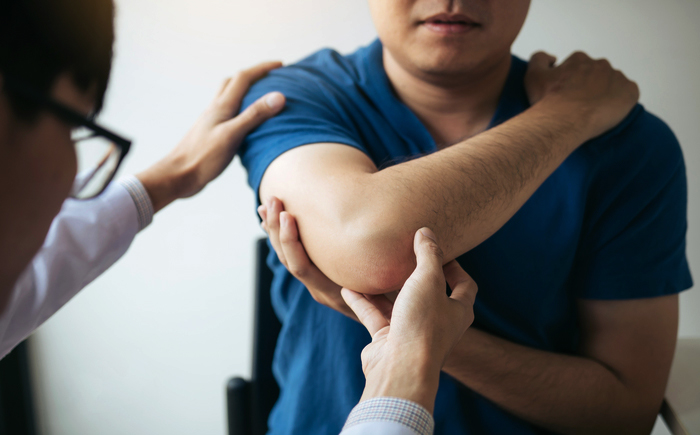UPPER ARM PAIN
Table of Contents
Upper Arm pain is characterized by pain, stiffness, or stiffness in one or even both arms. Injury and overuse are the most common causes. However, there is a slew of other health issues that may make your arm ache.
The underside of your bicep muscle may feel painful and likely have a noticeable bruise if the tricep is damaged. Arm discomfort may be caused by degenerative, inflammatory, or neurological conditions.
Rice is a method of treatment for a triceps bruise. There are many different types of upper arm pain when lifting arm. The condition known as biceps tendonitis is one of the most common causes of pain in upper arm .
The source of pain in right upper arm female discomfort should be addressed. Your doctor will most likely begin with a physical exam, but additional details about you, such as your work, activities, and prior injuries, as well as the site of the discomfort and the symptoms connected with it, may aid in the diagnosis.
Upper Arm Pain Symptoms
The symptoms of arm discomfort may vary depending on the reason. They may include the following:
- Redness in the arms
- Stiffness
- Swelling
- Lymph nodes beneath the arm that are enlarged
Upper Arm Pain Causes

There may be a variety of reasons why woman upper arm pain. Arm pain is characterized by pain, stiffness, or stiffness in one or even both arms, ranging from the shoulders to the fingertips. An injury and overuse are the most common upper arm pain causes.
The bone and muscles between the pain in upper right arm between elbow and shoulder. The main bone in this area is the humerus, as well as tendons, muscles, nerves, and ligaments, all of which may cause pain and suffering.
Reasons for dent in upper arm pain may have a variety of causes and symptoms, ranging from minor to severe. The following are some of the possible reasons for arm pain:
1. Nerves Pinched
- Bones
- Muscle
- Cartilage
- Tendons
Other signs and symptoms include:
- Tingling
- Numbness
- Severe discomfort
- A lack of muscular mass
2. Syndrome Of The Cubital Tunnel
- Injury to the Rotator Cuff
- Pinching of nerve in the neck
- Syndrome of the carpal nerve
- Bursitis
- Strain
- Arthritis
3. Various injuries, such as a broken bone or a stress fracture, may cause arm discomfort
- Elbow dislocation
- Fracture of the growth plate
- A laceration or a contusion is a laceration or a contusion
- Muscle that has been pulled or ripped
- Strains and sprains are common injuries.
4. Arm discomfort may be caused by an infection
Outside upper arm pain may be caused by a variety of infections, including:
- Cellulitis (inflammation of the intestines) (bacterial skin infection)
- A wound or even other sore that is infected
- Osteomyelitis is a kind of bone infection (bone infection)
- Arthritis septic (infectious arthritis)
5. Upper Arm Muscle Bruise
- Constant discomfort in the upper arm
- An injury to the afflicted area the rear of the arm (triceps) or its front arm (biceps) is known (bicep)
- One arm is swollen
- A bruise on the upper arm
When there is trauma to the region, the blood vessels that return the blood back to the heart are damaged, resulting in a bruised muscle This leads to blood pooling, resulting in a bruise that is blue or purple in hue.
Until the blood is absorbed by surrounding tissue or removed by the immune system, a bruise will remain evident. The underside of your bicep muscle may feel painful and likely have a noticeable bruise if the tricep is damaged. The front of your arm hurts when you have a bruised bicep.
Also, read this article
How Long Does It Take For A Broken Leg To Heal?
RICE is a Method of Treatment:
How to relieve upper arm pain? Arm discomfort may be caused by degenerative, inflammatory, or neurological conditions. Degenerative, inflammatory, and neurological disorders may all produce pain in the upper arm pain, including:
- Bursitis (inflammation of the bursa)
- Carpal tunnel syndrome (CTS).
- Stenosis of the cervical spine
- Spondylosis of the cervical spine
- Disc herniation in the neck
- Nerve trapping or pressure, such as the one that affects the arm’s ulnar nerve
- Osteoarthritis
- Neuropathy of the peripheral nerves, including diabetic neuropathy
- Tendinitis (tendon inflammation), such as golf elbow
Also, read this article
Why Do People Feel Back Pain When Breathing?
You may employ a number of therapies at home in addition to the medicines your doctor might prescribe for Home Remedies for Upper Arm Pain. The following are some examples of RICE home treatments for upper arm pain:
1. Rest
Sometimes all the brain needs is a good night’s sleep. Rest the painful region and stay away from excessive activity and movement.
2. Ice
Injuries may frequently benefit from icing to decrease swelling and inflammation. Apply an ice pack to the sore region for 20 minutes, wrapped in a towel. Between ice packs, wait at least an hour. Purchase ice packs.
3. OTC (over-the-counter) analgesics
If you don’t want to visit a arm pain doctor and the pain is minor, OTC pain relievers such as aspirin or ibuprofen may assist. Don’t take these medicines for longer than they’re supposed to be used.
4. Compression
Using an elastic wrap or brace to wrap the region where you’re in pain may assist decrease swelling and stop you from overextending a joint, promoting recovery. Purchase a brace and an elastic bandage.
5. Elevation
Elevate your arm to assist with swelling and discomfort. If any of these home treatments make your pain greater, stop using them right once and see your doctor.
Other Possibilities for Therapy: How do you Treat Upper Arm Pain?
- Surgery to remove heel spurs or disc protrusions in the spinal cord that may be causing problems may be required.
- Medications prescribed by a doctor, such as antibiotics for infections and steroids for the inflammatory process.
- Physical therapy or rehabilitation, particularly after an injury, can help you regain range of motion, strength, or stability in your shoulder.
- Acupuncture for serious pain relief.
- Cortisone injections into the elbow joint or surrounding pinched neurons in the neck may help decrease inflammation in the area.
Also, read this article: Learn Now the Strongest Muscle in the Human Body
Identifying the Source of Arm Discomfort
The source of arm discomfort should be addressed. Given the wide range of potential reasons, your doctor will need to determine if the pain is caused by the arm itself or is a sign of a disease somewhere else in your body.
The doctor will most likely begin with a physical exam, but additional details about you, such as your work, activities, and prior injuries, as well as the site of the discomfort and the symptoms connected with it, may aid in the diagnosis.
The doctor may request a scan to confirm a diagnosis, so if they suspect the pain is originating from someplace other than the arms, further testing may be required.
Best Exercise for Upper Arm Pain
After that, extend the right hand to the left behind your elbow and move the arm of the right to its left and then across the chest. Then lower the arms until discomfort eases. Maintain that position for 30-to-50 minutes, and then let it go.
Best Pain Relief for Upper Arm Pain
The treatment may begin with conservative methods, such as the over-the-counter medications aspirin, acetaminophen, and ibuprofen. These prescription-free medications are beneficial for specific types of arm pain if used by the directions. It is also possible to consider at-home treatment, such as drinking lots of fluids to lessen muscle cramps.
Best Pillow for Upper Arm Pain
Memory foam cushions are excellent for reducing neck and shoulder joint pain because they help cover every contour of the neck, head, and upper back parts. A few alternatives are medium-fill pillows. If you are allergic or sensitive to the down stuff, you can find excellent alternatives with medium-to-heavy fill.
Best Sleeping Position for Upper Arm Pain
A more comfortable side-sleeping posture can be achieved by sitting on the opposite side of the shoulder and pointing the shoulder, hurting upwards towards the ceiling. Place the pillow into your armpit on the injured shoulder to keep it in place and alleviate pressure on the rotator cuff muscles to achieve best way to sleep with upper arm pain.
Best Stretches For Upper Arm Pain
- Standing bicep stretch
- Bicep Stretched While Sitting
- Upper arms stretch in the doorway
- Bicep stretch on the wall
- The Horizontal Arm Extensions
- Wrist rotations that are horizontal
Frequently Ask Question
Does Breast Cancer Cause Upper Arm Pain?
After receiving a diagnosis of breast cancer, the cumulative rates of arm and shoulder stiffness, pain, and hand swelling in the arm were 43.0 percent (95 percent 95% ci 40.4-45.6), 35.8% (33.4-38.3) and 22.5 percent (20.4-24.8), based on 516, 618 and 319 women, respectively.
Does Frozen Shoulder Cause Upper Arm Pain?
The pain caused by a frozen shoulder is typically dull or aching. It can get worse when you attempt to move it. The pain is generally located on the shoulder’s outer side and often the upper arm.
Is Upper Arm Pain A Sign Of Heart Attack?
Arm pain, especially discomfort that extends into your left arm, could indicate a cardiac attack.
Why Do I Wake Up With Upper Arm Pain?
Some people experience pain when lying down on their upper arms. The “cup” of your shoulder and your lower avulsion fracture (humerus) are both continuously under pressure as a result of this posture (glenoid).
When Should you Visit a Doctor?
Get medical help right away if you have any of the symptoms listed:
- Pain in your upper arm pain, shoulder, or back that appears abruptly, is particularly intense, or is accompanied by chest pressure, fullness, or squeezing
- A visible malformation or protruding bones in your forearm or wrist, particularly if bleeding or even other injuries are present.
Consult your doctor right away if you develop any of the symptoms listed
- Arm, shoulder, or back problems that are eased by rest after any kind of activity – may indicate heart disease or pain in the chest caused by the diminished blood supply to your heart tissue (angina)
- An arm injury that occurs suddenly, especially if you hear a pop or cracking sound.
- Your arm is swollen and painful.
- You may have difficulty moving or twisting your arm from palm up to palm downwards and vice versa.
If you experience any of the following symptoms, make an appointment to see your doctor:
- Arm discomfort that persists after home treatment
- Increased edema, redness, or discomfort in the affected region
When Should You Seek Additional best treatment for upper arm pain?
Additional treatments may be needed depending on the underlying disease. We will send you to the proper specialty doctor if there is anything that has to be handled by another kind of expert.


